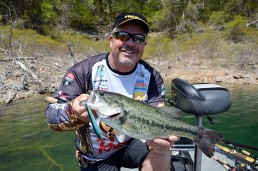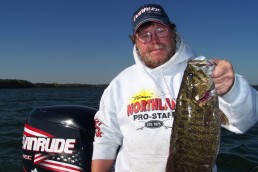Old Minnow Plugs and Spinners Still Catch Tons of Fish
SHARE THIS POST
Many people like to use the latest, greatest, most technologically advanced can’t-fail lures and rush out to buy them as soon as they hit the shelves or internet websites. Not my dad. He wouldn’t buy a lure until it had been on the shelf several years.
“Lures are designed to catch fishermen, not fish,” he admonished. “If a lure has been on the market several years, it catches fish. That’s the ones I want to buy.”
Many old standards date back more than 100 years, but they still catch fish. Some broke technological barriers at the time, but remain on the market relatively unchanged to this day.
For instance, John J. Hildebrandt came up with a great idea in 1893. A plumber by vocation and a dedicated fisherman by avocation, he used his wife’s hairpin and a dime to create a new fishing sensation. The Logansport, Ind., inventor flattened and reshaped the coin before drilling an offset hole through it. Then, he slipped the hairpin through the hole, fashioned an eye so he could tie line to it and attached a hook. When retrieved, the dime wobbled enticingly around the pin, giving off fish-attracting flash.
Many people laughed at the device, that is, until “Big John” started catching fish. Then, the contraption attracted so much attention that the plumber couldn’t keep up with demands to make more lures. In 1899, he founded the Hildebrandt Lure Company, ending his plumbing days forever and casting his way into fishing lure lore.
Now known as an in-line spinnerbait, Hildebrandt’s design eventually evolved into such lures as his own company’s Snagless Sally, Howard Worden’s Rooster Tail and an assortment of Mepps spinners. In-line spinnerbaits consist of one or more blades revolving around a central shaft. Even after more than a century, in-line spinnerbaits remain among the easiest lures to use and still catch fish. Often, young anglers catch their first fish on lures by “chunking and winding” in-line spinners.
Most in-line spinners come equipped with a single treble hook, often adorned with feathers or fur. Others come with plastic minnow trailers or similar temptations, perhaps sporting two or more treble hooks or maybe just a single Texas-rigged hook. Since treble hooks can snag easily, use in-line spinnerbaits in open water or around relatively less entangling cover. If anglers Texas-rig single hooks into soft plastic trailers, they can use these baits around thick grass.
In 1915, the William J. Jamison Company developed the Shannon Twin Spinner, which included two blades attached to a wire weed guard. By the early 1950s, this type of lure evolved into the common “safety pin” type of spinnerbait so popular among bass anglers today. Instead of a spinner revolving around a straight shaft, a “safety pin” spinnerbait features a bent wire “arm” that suspends one or more blades over a head that holds the hook. The wire arm can better deflect branches, stumps or other objects, making safety-pin spinners more able to slip through tight places.
Most safety pin spinnerbaits come equipped with some combination of blade types. Often, a lure might employ a main blade of one type and a smaller, secondary blade of another time to maximize the action.
Nearly round, Colorado blades sink faster, displace the most water and make more commotion. A good choice when fishing at night, in deep or extremely murky water, they create significant vibration that fish can more easily find.
Oblong willow-leaf blades resemble long, skinny tree leaves. They tend to run faster, rise quicker and can cut through vegetation better than Colorado blades. A willow-leaf blade probably offers the most subtle presentation, but it also gives off the most flash with more of a baitfish silhouette.
Longer than a Colorado, but not quite as long as a willow-leaf, a teardrop-shaped Indiana blade offers a compromise in shape and action. It gives both good vibration and flash.
These three blade types dominated the market for years. Another shape, an Oklahoma blade, features rounded, beveled corners and clipped edges. Some people call it a “turtleback” blade because it resembles a turtle shell. It vibrates more than a Colorado blade and gives off more flash than an Indiana. It does not flash quite as much as a willow-leaf, but makes a great combination blade.
A beetle or harness spinnerbait resembles the safety-pin type, but with a detachable wire arm hooked to a jig head. Moreover, instead of a plastic, vinyl or feathery skirt, the hook usually holds a soft plastic beetle, grub or minnow trailer. Anglers can easily reconfigure a harness spinner by changing the jighead or trailer to create a bait with an entirely different shape, color or action.
Today, thanks to people like John J. Hildebrandt and other innovative thinkers, few anglers venture to their favorite honey holes without an array of spinnerbaits in different sizes, configurations and colors. Among the most versatile baits on the market, these old lures still entice many fish species from top to bottom.
Are you enjoying this post?
You can be among the first to get the latest info on where to go, what to use and how to use it!

The lure fish still can’t pass up
Another innovative thinker, Lauri Rapala, worked part-time as a lumberjack and full-time as a commercial fisherman in Finland. In 1936, after observing nature while working as a commercial fisherman, the 31-year-old man struggling to support his family made some profound observations.
Alone tending his lines each day on Lake Paijanne, Rapala observed how fish interact with each other. First, he noticed that big fish eat smaller fish. Second, he observed how predators slash into a school of baitfish, wounding several and always returning to single out struggling ones swimming with a slight wobble. Armed with that information, he set out to create a wobbling lure that mimicked wounded baitfish. If he created an artificial bait that fish would attack, he wouldn’t need to spend so much time and money obtaining bait and putting it on his lines.
Rapala carved, filed and sanded cork chunks into various shapes. Finally, the fisherman came up with a design he liked. Rapala wrapped his creation in tinfoil and coated the body with melted photographic negatives to seal it because he could not obtain lacquer. With a black back, gold sides and white belly, the lure resembled a minnow. According to some stories, Lauri and his sons, Risto and Ensio, caught more than 600 pounds of fish with the lure on some days. Soon, other fishermen begged Rapala to carve similar lures for them, which became known as the Rapala Original Floater.
By 1959, Normark began distributing the Rapala Original Floater in the United States, but sales really skyrocketed three years later. In August 1962, Life magazine broke all-time single issue sales records with a cover shot featuring Marilyn Monroe and articles lamenting the recent death of the screen legend. However, another article in that issue headlined “A Lure Fish Can’t Pass Up,” spawned a new legend and catapulted sales for Rapala’s design. Today, the company Rapala founded now sells more than 20 million lures in more than 140 countries each year.
Growing up bass fishing in shallow south Louisiana marshes, I commonly used only two lures, a black, gold and white or a black back and white Rapala. With a light spinning rod, I tossed it to a grassy edge and let it sit for a second or two. Then, I jerked the rod vigorously. The lure plunged a foot or two into water typically less than three feet deep. When it floated back to the surface, I jerked it again. Sometimes, I just shook the rod a bit to twitch the bait on the surface. Sometimes, I reeled the lure back to the boat, making it wobble a foot or two below the water. I didn’t even know enough to call it a “jerkbait” back then. I just knew it caught tons of fish, and produced awesome strikes.
“Jerkbait” simply defines any long, slender minnow-like diving lure that anglers jerk to give action. Typically, it comes with a short plastic lip, making it dive a foot or two. It fills a niche between “true” floating topwater baits and deeper diving crankbaits. Some come with rattles for more fishing-calling enticement.
Besides the typical floating hard plastic or wooden creations, some jerkbaits slowly sink or suspend at certain depths. These often look almost identical to floating models, but feel a bit heavier. Toss them to a good area and let them sink. Anglers frequently estimate the sink rate by counting down by “one-thousands.” At the desired depth, jerk it to let it dart and dash, then pause. Bass often strike as the bait sits motionless at the proper depth. Resembling dying shad, suspended jerkbaits work effectively in very clear water.
Jerkbaits with soft plastic bodies rather than wood or hard plastic hit the market a few decades ago. Anglers can rig these slow-sinking creations to run where traditional floating jerkbaits cannot go by inserting the hooks into the plastic bodies. Fish these baits weightless over or through weed patches and thick cover with a pop-and-stop method. Pause frequently to let them sink into open pockets.
Although soft plastic jerkbaits work extremely well with no weight, they can also attract fish with a weight attached. Attach a 1/8- to 1/4-ounce slip sinker to the line in front of a soft plastic jerkbait. Use just enough weight to pull the lure to the bottom or the desired depth. When the weight carries the lure down, it looks like a dying shad. Add a little popping action at the right depth to give the lure a fast, erratic darting action.
Relatively unchanged for more than seven decades, except switching from cork bodies to balsa wood, the Rapala Original Floater still catches many fish species all over the world. Rapala probably contributed to more world records than any other type of lure. Over the years, many companies copied Lauri Rapala’s simple design and sold their own jerkbaits in various configurations and sizes.
Maybe Dad was right after all. Sometimes, the oldest designs still produce the best fishing action.
John N. Felsher grew up in Slidell, La, and now lives in Semmes, Ala. He’s a professional freelance writer and photographer with more than 2,100 articles in more than 135 different magazines to his credit. Contact him through his website at JohnNFelsher.com.
MWO
SHARE THIS POST
Did you enjoy this post?
You can be among the first to get the latest info on where to go, what to use and how to use it!
John N. Felsher
John N. Felsher grew up in Slidell, La., and now lives in Semmes, Ala. He’s a professional freelance writer and photographer with more than 2,100 articles in more than 135 different magazines to his credit. He also co-hosts a weekly live outdoors radio show every Thursday from noon to 1 p.m. Central Time on WNSP 105.5 FM in Mobile, Ala. and a recorded syndicated show that goes out to multiple stations in Alabama each week. For more info on the syndicated show, see gdomag.com. Contact him at JohnNFelsher.com.



